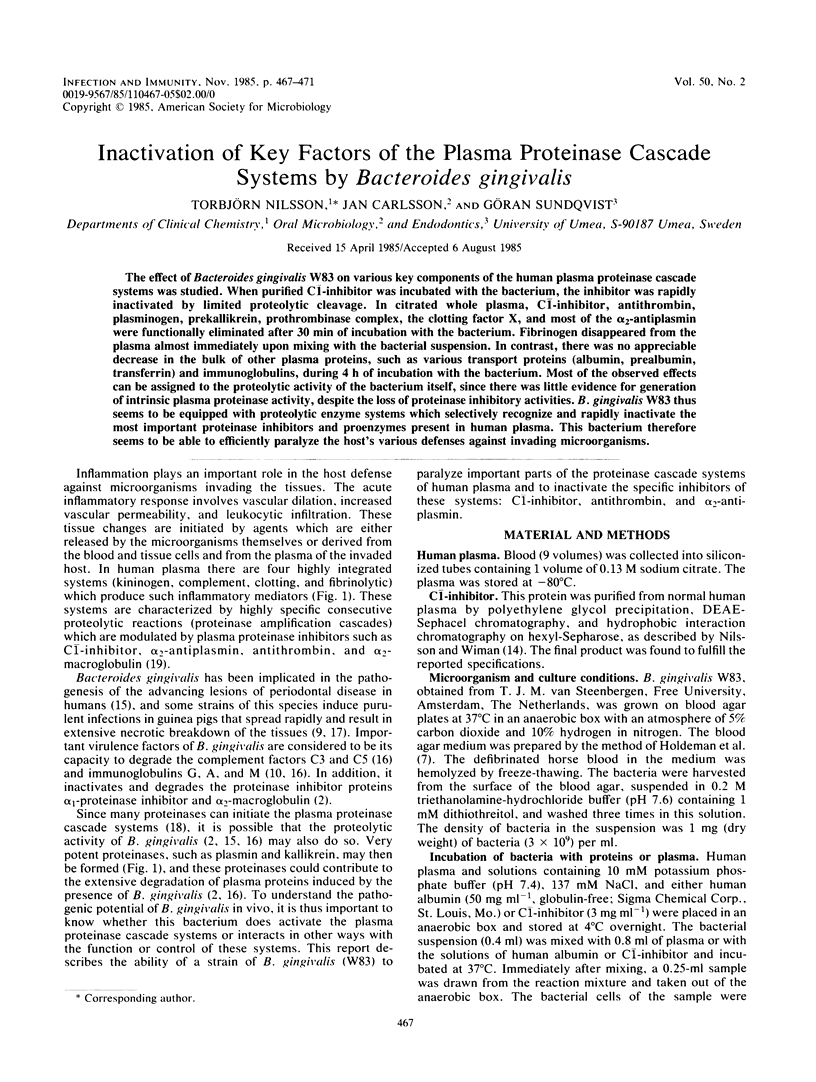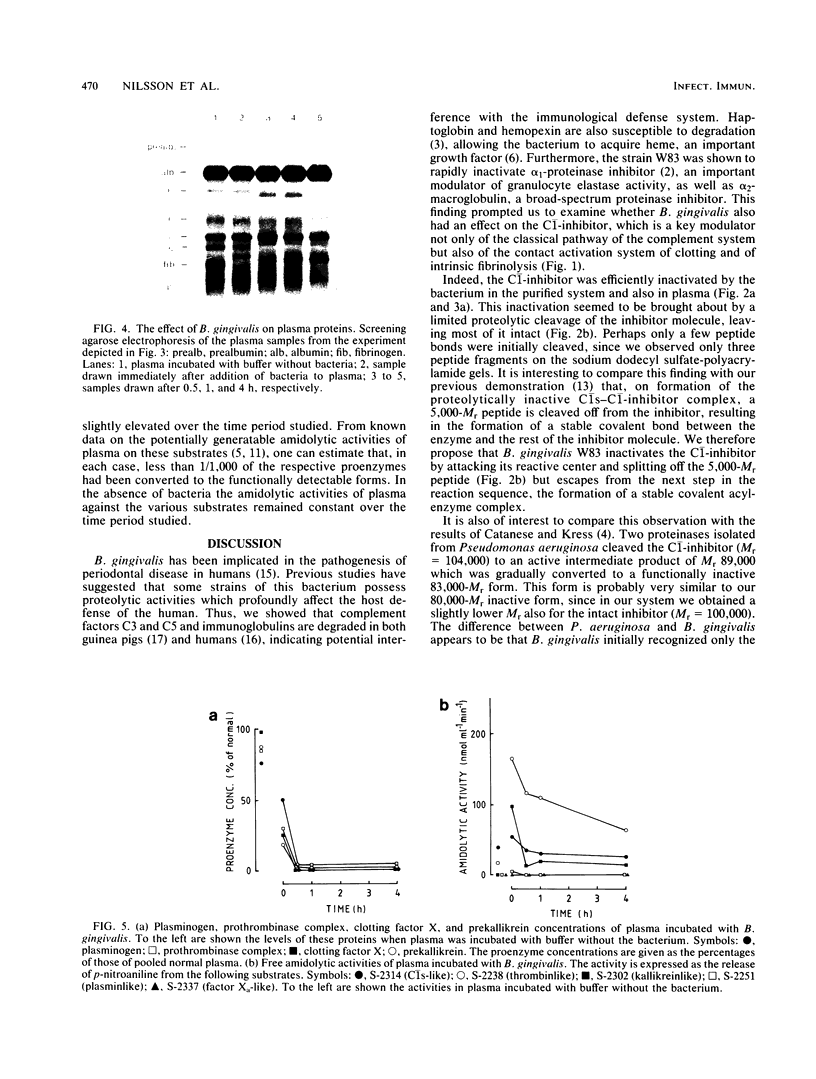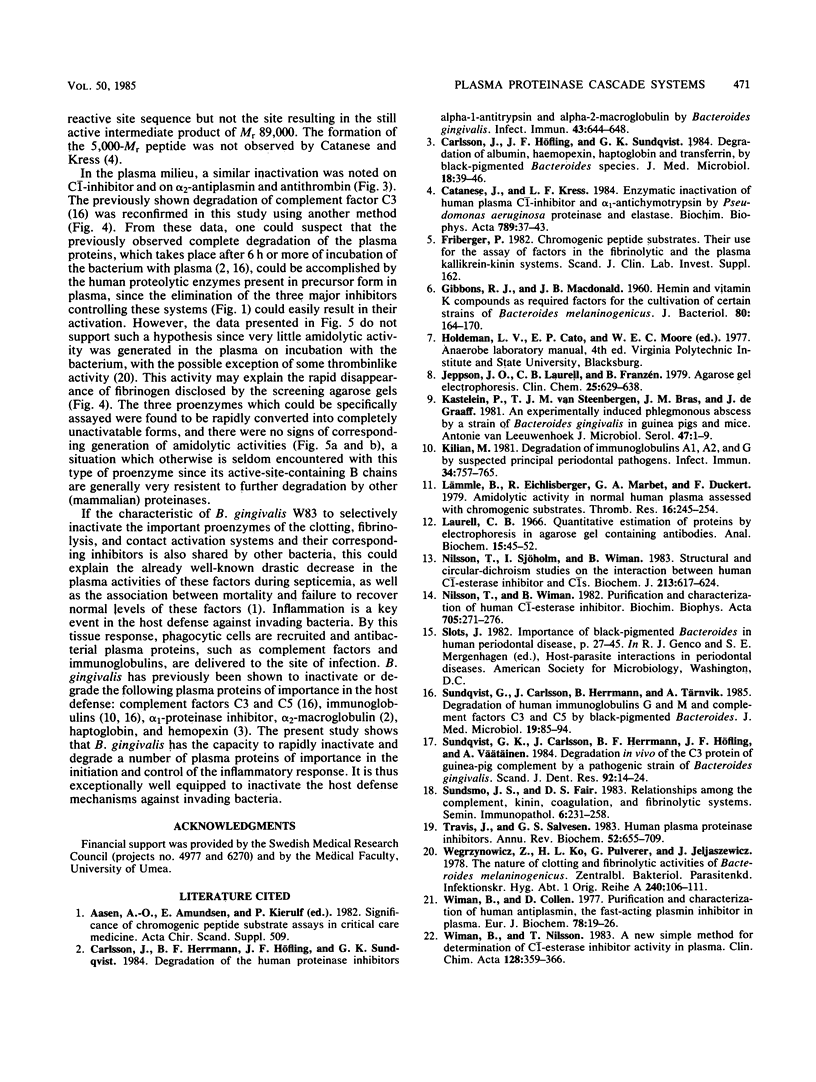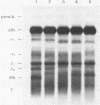Abstract
The effect of Bacteroides gingivalis W83 on various key components of the human plasma proteinase cascade systems was studied. When purified C1-inhibitor was incubated with the bacterium, the inhibitor was rapidly inactivated by limited proteolytic cleavage. In citrated whole plasma, C1-inhibitor, antithrombin, plasminogen, prekallikrein, prothrombinase complex, the clotting factor X, and most of the alpha 2-antiplasmin were functionally eliminated after 30 min of incubation with the bacterium. Fibrinogen disappeared from the plasma almost immediately upon mixing with the bacterial suspension. In contrast, there was no appreciable decrease in the bulk of other plasma proteins, such as various transport proteins (albumin, prealbumin, transferrin) and immunoglobulins, during 4 h of incubation with the bacterium. Most of the observed effects can be assigned to the proteolytic activity of the bacterium itself, since there was little evidence for generation of intrinsic plasma proteinase activity, despite the loss of proteinase inhibitory activities. B. gingivalis W83 thus seems to be equipped with proteolytic enzyme systems which selectively recognize and rapidly inactivate the most important proteinase inhibitors and proenzymes present in human plasma. This bacterium therefore seems to be able to efficiently paralyze the host's various defenses against invading microorganisms.
Full text
PDF




Images in this article
Selected References
These references are in PubMed. This may not be the complete list of references from this article.
- Carlsson J., Herrmann B. F., Höfling J. F., Sundqvist G. K. Degradation of the human proteinase inhibitors alpha-1-antitrypsin and alpha-2-macroglobulin by Bacteroides gingivalis. Infect Immun. 1984 Feb;43(2):644–648. doi: 10.1128/iai.43.2.644-648.1984. [DOI] [PMC free article] [PubMed] [Google Scholar]
- Carlsson J., Höfling J. F., Sundqvist G. K. Degradation of albumin, haemopexin, haptoglobin and transferrin, by black-pigmented Bacteroides species. J Med Microbiol. 1984 Aug;18(1):39–46. doi: 10.1099/00222615-18-1-39. [DOI] [PubMed] [Google Scholar]
- Catanese J., Kress L. F. Enzymatic inactivation of human plasma C1-inhibitor and alpha 1-antichymotrypsin by Pseudomonas aeruginosa proteinase and elastase. Biochim Biophys Acta. 1984 Aug 28;789(1):37–43. doi: 10.1016/0167-4838(84)90057-8. [DOI] [PubMed] [Google Scholar]
- GIBBONS R. J., MACDONALD J. B. Hemin and vitamin K compounds as required factors for the cultivation of certain strains of Bacteroides melaninogenicus. J Bacteriol. 1960 Aug;80:164–170. doi: 10.1128/jb.80.2.164-170.1960. [DOI] [PMC free article] [PubMed] [Google Scholar]
- Jeppsson J. O., Laurell C. B., Franzén B. Agarose gel electrophoresis. Clin Chem. 1979 Apr;25(4):629–638. [PubMed] [Google Scholar]
- Kilian M. Degradation of immunoglobulins A2, A2, and G by suspected principal periodontal pathogens. Infect Immun. 1981 Dec;34(3):757–765. doi: 10.1128/iai.34.3.757-765.1981. [DOI] [PMC free article] [PubMed] [Google Scholar]
- Laurell C. B. Quantitative estimation of proteins by electrophoresis in agarose gel containing antibodies. Anal Biochem. 1966 Apr;15(1):45–52. doi: 10.1016/0003-2697(66)90246-6. [DOI] [PubMed] [Google Scholar]
- Lämmle B., Eichlisberger R., Marbet G. A., Duckert F. Amidolytic activity in normal human plasma assessed with chromogenic substrates. Thromb Res. 1979;16(1-2):245–254. doi: 10.1016/0049-3848(79)90285-8. [DOI] [PubMed] [Google Scholar]
- Nilsson T., Sjöholm I., Wiman B. Structural and circular-dichroism studies on the interaction between human C1-esterase inhibitor and C1s. Biochem J. 1983 Sep 1;213(3):617–624. doi: 10.1042/bj2130617. [DOI] [PMC free article] [PubMed] [Google Scholar]
- Nilsson T., Wiman B. Purification and characterization of human C1-esterase inhibitor. Biochim Biophys Acta. 1982 Jul 26;705(2):271–276. doi: 10.1016/0167-4838(82)90188-1. [DOI] [PubMed] [Google Scholar]
- Sundqvist G. K., Carlsson J., Herrmann B. F., Höfling J. F., Vätäinen A. Degradation in vivo of the C3 protein of guinea-pig complement by a pathogenic strain of Bacteroides gingivalis. Scand J Dent Res. 1984 Feb;92(1):14–24. doi: 10.1111/j.1600-0722.1984.tb00854.x. [DOI] [PubMed] [Google Scholar]
- Sundqvist G., Carlsson J., Herrmann B., Tärnvik A. Degradation of human immunoglobulins G and M and complement factors C3 and C5 by black-pigmented Bacteroides. J Med Microbiol. 1985 Feb;19(1):85–94. doi: 10.1099/00222615-19-1-85. [DOI] [PubMed] [Google Scholar]
- Sundsmo J. S., Fair D. S. Relationships among the complement, kinin, coagulation, and fibrinolytic systems. Springer Semin Immunopathol. 1983;6(2-3):231–258. doi: 10.1007/BF00205875. [DOI] [PubMed] [Google Scholar]
- Travis J., Salvesen G. S. Human plasma proteinase inhibitors. Annu Rev Biochem. 1983;52:655–709. doi: 10.1146/annurev.bi.52.070183.003255. [DOI] [PubMed] [Google Scholar]
- Wegrzynowicz Z., Ko H. J., Pulverer G., Jeljaszewicz J. The nature of clotting and fibrinolytic activities of Bacteroids melaninogenicus. Zentralbl Bakteriol Orig A. 1978 Jan;240(1):106–111. [PubMed] [Google Scholar]
- Wiman B., Collen D. Purification and characterization of human antiplasmin, the fast-acting plasmin inhibitor in plasma. Eur J Biochem. 1977 Aug 15;78(1):19–26. doi: 10.1111/j.1432-1033.1977.tb11709.x. [DOI] [PubMed] [Google Scholar]
- Wiman B., Nilsson T. A new simple method for determination of C1-esterase inhibitor activity in plasma. Clin Chim Acta. 1983 Mar 14;128(2-3):359–366. doi: 10.1016/0009-8981(83)90335-2. [DOI] [PubMed] [Google Scholar]




